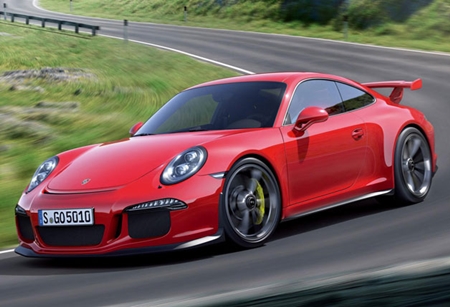Well, I don’t know about you, but I certainly would be happy to push the Daihatsu Mira into the street and put a new Porsche in my garage. (It has been a long time since a 911 was my daily drive car, but those years are never forgotten.)
For me, it is no surprise that Porsche’s development head, Wolfgang Hatz, said, “The performance figures will really surprise you. But it is not the performance figures that make it so memorable. It is the emotional appeal. It gets under your skin.” I could not agree more. Anyone who has ever owned a 911 and currently without one, will describe themselves as being “between Porsche’s.”
 911 GT3
911 GT3
The basic bodyshell is shared with the 911 Carrera S, with the adoption of aluminium for the fenders, roof, doors and engine lid claimed to have reduced the weight of the structure by 13 per cent over the second-generation 911 GT3, while additional strengthening measures bring about a massive 25 percent increase in torsional rigidity. It is larger by 118 mm in length and 44 mm in width, and the new 911 GT3 hits the scales at 1430 kg, 35 kg heavier than the previous model.
At 2457 mm, the wheelbase represents a considerable 93 mm increase over the old 911 GT3, while the front and rear tracks are up by 54 mm and 31 mm in width at 1551 mm and 1555 mm respectively, giving it a much wider stance.
Gear lever goes into drive without the need to depress a clutch pedal. The dual clutch gearbox automatically picks up first, second and then third as required.
The new engine produces 350 kW some 250rpm below the point where the old 911 GT3 unit was redlined at 8250rpm. Torque is up by 10 Nm, reaching 440 Nm at 6250rpm.
Porsche’s latest road racer returns a 0-100 km/h time of 3.5sec, eclipsing its predecessor by an impressive 0.4sec. The revised gearing also means its 315 km/h top speed is achieved in seventh gear – not sixth, as with the 911 Carrera S.
In keeping with previous incarnations of the GT3, the new model receives a largely unique chassis. The layout, with a MacPherson strut front and five-link rear suspension, is carried over from other new 911 models, but the individual components have been extensively modified in a move that brings about a 30 mm lowering in ride height and 3.9 kg reduction in weight for reduced unsprung mass.
The new GT3 gets revised wheel bearings, altered hubs, a new transverse control arm, lighter springs and aluminium tube dampers are among the developments found up front. The rear gets a similar list of measures, together with a hollow aluminium subframe casting that provides a more rigid mounting structure. A variable damping system (PASM) with two levels of firmness is part of the standard equipment, as is torque vectoring (PTV Plus) that includes a locking differential. The standard fit center-lock, forged-aluminium 20 inch wheels have increased in diameter but are claimed to be marginally lighter than the 19 inch items used on the old GT3. They are now 9.0 inch wide up front and 12.0 inches wide at the rear and come shod with 245/35 and 305/30 profile Dunlop Sport Maxx tyres respectively.
The steering is also completely new and rather special. The front electro-mechanical system is a development of the arrangement used on the 911 Carrera S but receives its own individual mapping and a revised mounting process to provide added rigidity to the rack. As on the upcoming 911 Turbo, it works in conjunction with an electro-mechanical rear-wheel steer system, which has been set-up to provide 1.5 degrees of steering angle at the rear. Up to 60km/h, it operates the rear wheels in the opposite direction to those up front, providing added low speed maneuverability by providing a virtual shortening of the wheelbase by 150mm. Above 80km/h, the rear wheels are operated parallel to the front wheels, resulting in a virtual lengthening of the wheelbase by 500 mm for added longitudinal stability.
To experience this car at its best you need a circuit, because its ability to carry big speeds through corners without any premature breakaway on road legal tyres is quite remarkable, as exemplified by Porsche’s claim that the new car has already successfully lapped the Nurburgring in 7 min 25 sec – two seconds faster than the even more heavily focused 911 GT3 RS 4.0 which it effectively replaces.
The brakes provide fantastic stopping power with superb levels of modulation and impressive feel even before they’re up to proper operating temperature. Porsche has given its new race bred coupe standard carbon-ceramic discs with six pot aluminium calipers up front and four-pot calipers at the rear. They’re now 350 mm in diameter all round and have been modified with altered ventilation holes for improved heat dissipation in a process brought over directly from its motorsport activities. There are also additional brake cooling ducts on the rear axle.
A day driving the new 911 GT3 reveals a significantly faster, even more responsive yet more accessible and astonishingly user-friendly car. But at the same time, it has lost none of the customary race track derived qualities when you switch into sport and give it all it is worth on a deserted country road.




